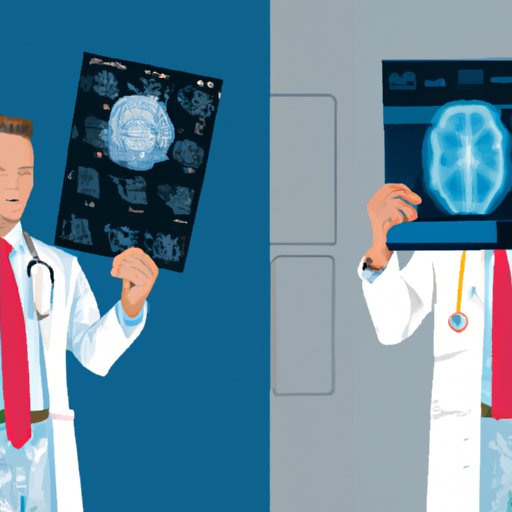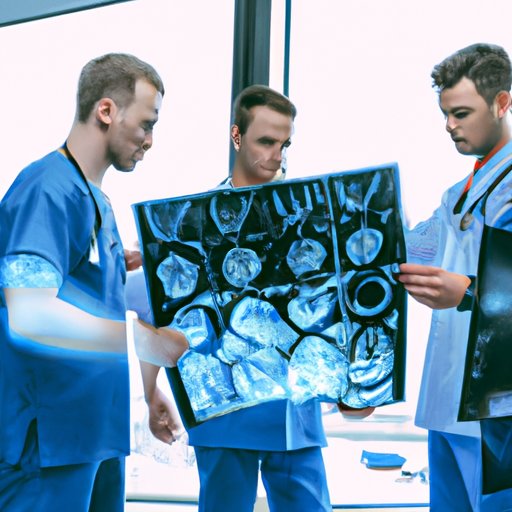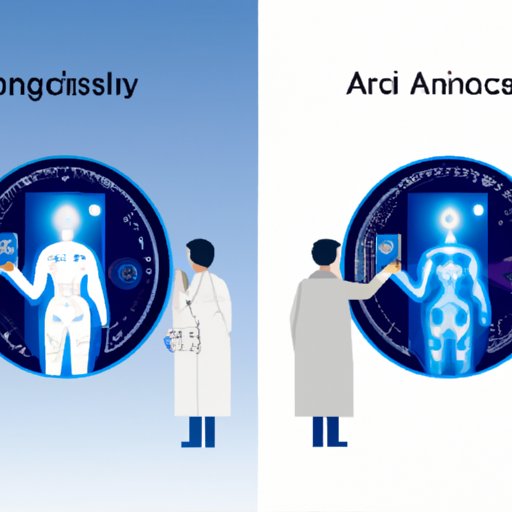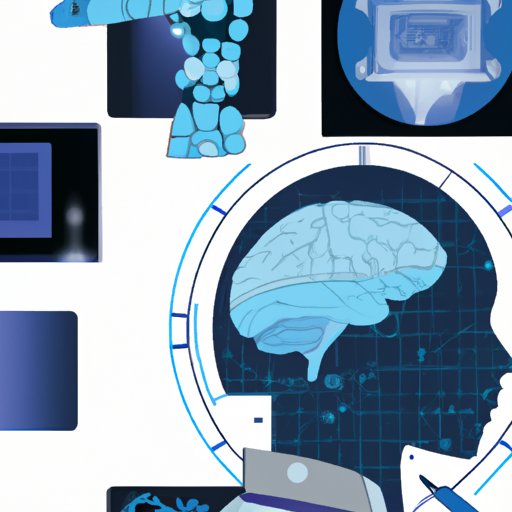Introduction
Artificial Intelligence (AI) has become an increasingly popular tool in many industries, and its potential applications in the medical field are particularly exciting. One such application is the use of AI to replace radiologists in the diagnosis of medical imaging. This article will explore the pros and cons of replacing radiologists with AI, examine the impact of AI on radiologists from a professional perspective, compare the accuracy of AI diagnoses to human diagnoses in radiology, analyze the cost-benefit analysis of utilizing AI in radiology, investigate patient attitudes toward AI-assisted radiology diagnoses, and evaluate the ethical implications of AI replacing radiologists.

Exploring the Pros and Cons of Replacing Radiologists with AI
The use of AI in radiology has the potential to revolutionize the industry by providing faster and more accurate diagnoses. By leveraging machine learning algorithms, AI can detect patterns in medical images that may be too subtle for the human eye to detect. This could lead to more accurate diagnoses and improved patient outcomes. Additionally, AI-assisted diagnoses could reduce the need for costly and time-consuming manual reviews of medical images.
However, there are several disadvantages associated with the use of AI in radiology. For example, AI systems require large amounts of data to be effective. This means that they may not be able to provide accurate diagnoses in cases where there is limited or no data available. Additionally, AI systems are only as good as the data they are trained on. If the data used to train the system is biased or incomplete, the results may be inaccurate or incomplete.

Examining the Impact of AI on Radiology from the Perspective of Radiologists
The introduction of AI into the radiology field could have a significant impact on radiologists. The most obvious change would be to the job description. Radiologists would no longer be responsible for reviewing and interpreting medical images; instead, they would be responsible for overseeing and managing AI systems. This could potentially lead to changes in job titles and responsibilities.
From a job security perspective, the introduction of AI could have both positive and negative effects. On the one hand, AI could reduce the number of radiologists needed to interpret medical images. On the other hand, it could create new jobs for radiologists who are trained to manage and oversee AI systems. Additionally, AI could free up radiologists’ time, allowing them to focus on more complex cases and improving patient care.

Comparing the Accuracy of AI Diagnoses to Human Diagnoses in Radiology
One of the most important considerations when evaluating the use of AI in radiology is accuracy. In order to accurately assess the effectiveness of AI-assisted diagnoses, it is necessary to establish a baseline for comparison. To do this, researchers have compared the accuracy of AI-assisted diagnoses to the accuracy of human diagnoses.
In one study, researchers evaluated the accuracy of AI-assisted diagnoses in the detection of pulmonary nodules in chest CT scans. The researchers found that the AI system was able to detect nodules with greater accuracy than the average radiologist. In another study, researchers compared the accuracy of AI-assisted diagnoses to human diagnoses in the detection of breast cancer in mammograms. The researchers found that the AI system was able to detect breast cancer with greater accuracy than the average radiologist.
Analyzing the Cost-Benefit Analysis of Utilizing AI in Radiology
When evaluating the use of AI in radiology, it is important to consider both the cost savings and the quality of care. From a cost perspective, AI-assisted diagnoses could reduce costs associated with labor, as fewer radiologists would be required to interpret medical images. Additionally, AI-assisted diagnoses could improve efficiency by reducing the amount of time required to review and interpret medical images.
However, it is also important to consider the quality of care. AI-assisted diagnoses could potentially lead to more accurate diagnoses, which could improve patient outcomes. Additionally, AI-assisted diagnoses could reduce the risk of human error, which could lead to better patient safety.
Investigating Patient Attitudes Toward AI-Assisted Radiology Diagnoses
It is also important to consider how patients feel about the use of AI in radiology. Studies have shown that the majority of patients are comfortable with the idea of AI-assisted diagnoses. However, there is still some concern among patients regarding the accuracy and reliability of AI-assisted diagnoses.
Additionally, studies have found that patients prefer to receive their diagnoses from a human radiologist rather than an AI system. This suggests that even if AI-assisted diagnoses become more accurate and reliable, patients may still prefer to receive their diagnoses from a human radiologist.
Evaluating the Ethical Implications of AI Replacing Radiologists
Finally, it is important to consider the ethical implications of AI replacing radiologists. One of the main concerns is the impact on patient care. If AI-assisted diagnoses lead to more accurate and reliable diagnoses, then this could lead to improved patient outcomes. However, there is also the potential for AI-assisted diagnoses to be biased or inaccurate, which could lead to poorer patient care.
Additionally, there are considerations regarding autonomy and accessibility. AI-assisted diagnoses could make medical imaging more accessible to those in underserved communities. However, there is also the potential for AI-assisted diagnoses to be less accessible to certain populations due to algorithmic bias.
Conclusion
This article examined the implications of Artificial Intelligence replacing radiologists and explored the pros and cons of automated diagnoses. It also evaluated the accuracy of AI-assisted diagnoses and analyzed the cost-benefit analysis of utilizing AI in radiology. Additionally, the article investigated patient attitudes toward AI-assisted radiology diagnoses and evaluated the ethical implications of AI replacing radiologists.
Overall, it appears that AI-assisted diagnoses have the potential to revolutionize the radiology field by providing faster and more accurate diagnoses. However, there are still several challenges that must be addressed before AI-assisted diagnoses can be fully adopted in the medical field. These include ensuring accuracy and reliability, addressing ethical concerns, and understanding patient preferences.
(Note: Is this article not meeting your expectations? Do you have knowledge or insights to share? Unlock new opportunities and expand your reach by joining our authors team. Click Registration to join us and share your expertise with our readers.)
